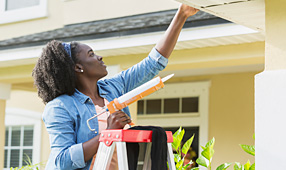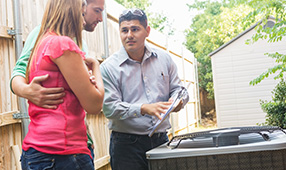When you first glimpse the monthly mortgage payment on your new dream home, those inevitable second thoughts are commonly called “buyer’s remorse.”
And when all of the wonderful stuff—refrigerators, ovens, dishwashers, heating/AC units, etc.—in your not-so-new-anymore home starts breaking down, you could call that feeling of angst “homeowner’s remorse.”
Replacing expensive items throughout the lifetime of your home is inevitable. It’s part of the cost of owning your own piece of property. Here’s how to make sure these repairs don’t catch you by surprise.
Step 1: Start saving enough money
The fact that these expenses are inevitable means you know you should be preparing for them right now. Experts recommend setting aside at least 1% of your home’s purchase price to cover a year’s worth of repairs. For example, if your home cost $300,000, you should save $3,000 each year specifically for home repairs.
You can get a better sense of the coming year’s expenses by evaluating the warranty terms of your household appliances and systems.
“In business school, we were taught to design products that have a non-failure warranty rate of 95% during the warranty, but a high failure rate afterward,” says Bruce Ailion, a certified real estate broker for RE/MAX Greater Atlanta and veteran property manager. “That’s why so many fail within a year of the warranty expiring.”
What happens in the worst-case scenario—a “double whammy” in which two expensive items start breaking down simultaneously, and you simply don’t have enough in savings to cover the repairs or replacements?
Ailion recommends borrowing money at the lowest possible interest rate to take care of the situation. “It’s better to borrow to fix or replace something in disrepair than allow it to linger and get worse,” he says, adding that the typical home gets two service calls a year for major fixes/replacements.
Step 2: Assess what might break down soon
You can extend the lifetime of items and systems through proper maintenance. Below are Ailion’s estimations of how long you can expect big-ticket items to last—plus some suggestions on how to make them last longer:
Roof: This granddaddy of replacements can soar well into thousands or even tens of thousands, depending on the size of your roof, the materials needed and the complexity of the job. If your existing roof was installed on the cheap, expect it to last only 10 to 18 years. Quality products will last 20 to 30 years.
How your home is sited also affects your roof’s life span. “Roofs that get full sun will deteriorate faster than those that don’t,” says Ailion, who currently manages an estimated 130 single-family properties. “A well-maintained roof—with leaves kept off of it—will last longer. You should check your attic for small leaks and fix a small problem before it becomes a big one.”
Heating/AC systems: Generally, expect eight to 15 years for the AC and 15 to 30 years for heating. “Changing filters adds years to the life,” Ailion says. “You’ll know the overall system is breaking down when smaller items go down, like the blower motor, control boards, etc.”
Hot water heater: Eight to 12 years.
Dishwasher: Three to six years. When the machine starts to get noticeably louder during the wash cycle, you may be due for a repair or replacement.
Washer/dryer: Eight to 12 years.
Refrigerator: 10 to 15 years.
Oven/range: 10 to 15 years.
Electrical wiring: Expect a nice, long life—usually about 50 years. “Yet, circuit breakers can still fail in the first year,” Ailion says.
Faucets: 10 to 20 years. “However, at 10 years old, styles will change, and your faucets may no longer look as attractive to you,” Ailion says. If you’re more interested in function rather than aesthetics, you’ll be in good shape for a long time.
Toilets: 15 to 25 years.
House siding: 30 to 100 years for standard vinyl or aluminum products. Wood siding may last only 15 years because it requires regular painting and caulking. “A good brick exterior will last 100 years or more, with much lower maintenance,” Ailion says.
Indoor plumbing pipes: 50 to 100 years. “Turn off the exterior faucets when winter comes, and keep pipes in crawl spaces insulated, or you’ll risk only getting one to three years out of them,” Ailion says.
Another option for affording home repairs is to get a home warranty—before things start breaking. Read our article “Buy Peace of Mind with a Home Warranty” to find out whether this would be a good option for you.












